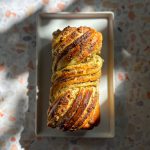Za’atar & Feta Babka
- Yield: 2 babkas 1x
Ingredients
Scale
Babka Dough:
- ½ cup + 1 ½ tsp (120g) whole milk, lukewarm (110–115°F)
- 2 tsp dry yeast
- 2 1/3 cups (280g) all-purpose flour
- 2 cups (220g) cake flour
- 2 large eggs, room temp
- 6 Tbsp (75g) granulated sugar
- ¼ tsp salt
- 5 Tbsp + 2 tsp (80g) unsalted butter, cubed & room temp
Za’atar & Feta Filling:
- 12 ounces (340g) full fat cream cheese, softened & divided
- 4 ounces (115g) feta cheese, crumbled & divided
- 1 Tbsp extra-virgin olive oil, divided
- 4 Tbsp Burlap & Barrel Za’atar, divided
Egg Wash:
- 1 large egg
- 1 Tbsp water
- pinch of salt
Post-Bake Toppings:
- 2–3 Tbsp extra-virgin olive oil
- Burlap & Barrel Za’atar
Instructions
Babka Dough:
- In the bowl of your stand mixer, gently stir together lukewarm milk, yeast, and a pinch of granulated sugar. Leave undisturbed for 5–10 minutes until the mixture gets foamy.
- Sift all-purpose flour and cake flour together.
- After proofing yeast, add other ingredients in this order: flours, eggs, sugar, salt, then cubed butter.
- Attach dough hook. Mix on low until dough has come together, scraping down bowl sides and bottom as needed (2–3 minutes).
- Increase mixer speed to medium. Knead dough until it’s elastic and smooth (4–5 minutes).
- Tip dough out onto a lightly floured work surface, then lightly flour top of dough. Hand-knead dough until it can pass the windowpane test (5–10 minutes).
- Lightly flour your mixer bowl. Form dough into a ball and place into bowl. Cover bowl with beeswax wrap or cling film and let dough rest for 30 minutes.
- After dough has rested, wrap in cling film, then press into a patty shape about 1-inch thick. Place wrapped dough in fridge for 24 hours. See you back here tomorrow!
Assembly & Baking:
- Welcome back! Grease two 9" x 5" loaf pans and line with parchment paper slings. Set aside.
- Retrieve dough from fridge, then divide into two equal pieces. (Each piece will weigh about 430g.) Place one dough blob on a lightly floured surface. Cover the other dough blob with a clean dish towel.
- Roll dough into a 12" x 14" rectangle. Using an offset spatula, spread half of softened cream cheese (6 oz / 170g) onto dough, leaving a bare 0.5–1" border.
- Scatter half of crumbled feta (2 oz / 58g) on top of cream cheese, pressing down gently to adhere.
- Drizzle ½ tablespoon of olive oil over cheese. Sprinkle 2 tablespoons of za’atar on top.
- Stand with one of the 14-inch sides closest to you. Lightly brush opposite bare edge with water. Starting with the long edge closest to you, gently—yet tightly—roll dough up into a log. Pinch moistened seam and ends to seal. Place seam side down prepared baking sheet. Repeat with remaining dough and filling.
- Place baking sheet and dough logs in fridge for 20–30 minutes (Chilled dough is easier to cut and twist.)
- After dough logs have chilled, retrieve baking sheet from fridge.
- Using a sharp knife, trim 0.5" from dough ends. Cut babka log lengthwise, leaving 1" at top attached. [1]
- Starting at the connected top, cross one side of the dough over the other. Repeat 2–3 times, keeping the cut side facing upwards. Pinch ends together. [2]
- Place babka into prepared loaf pan. Cover loosely with cling film.
NOTE: We find the easiest way to transfer and place the babka is to gently lift it up from underneath with both hands. Place centre of babka into centre of pan first. Then, if your babka is too long for the pan, curl and tuck the ends under the babka while setting into pan. - Repeat process with second dough log.
- Place pans in a warm, dry spot and leave undisturbed for 2–3 ½ hours until babkas are soft and visibly puffy.
- While babkas are proofing, heat oven to 350°F.
- When babkas are ready to bake, make egg wash by whisking together egg, water, and salt. Brush over babkas.
- Bake for 40–45 minutes or until golden brown. (The internal temperature should be 190–200°F.) If tops or edges are browning too quickly, tent with foil.
- Remove loaves from oven and place pans on wire rack. Gently brush hot babkas with olive oil, then sprinkle on additional za’atar.
- Allow babkas to cool in pans for 20–30 minutes, then remove from pans by pulling up on the parchment slings.
- Enjoy warm or at room temperature!
Notes
- Save those dough ends! We put all 4 dough ends into a lined mini loaf pan and let proof. Once the babkas were done, we baked our tiny loaf in a 350°F oven for 20–25 minutes. Bonus baker treat!
- When forming the babkas, this article from King Arthur and this video from Red Star Yeast may come in handy. It can be a messy process, but just hold the dough together the best you can.
Adapted from: Uri Scheft
Find it online: https://recipes.fikabrodbox.com/zaatar-and-feta-babka/
